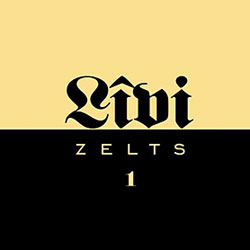
Even though they are one of the biggest Latvian rock acts, Līvi’s back catalogue has long been out of print. Albums such as Iedomu pilsēta and the self-titled Līvi are available only on vinyl, if at all. And as with many other Latvian artists, not all the group’s early songs were released on proper albums, but appear on multi-group collections such as the old yearly releases from Mikrofons.
Fortunately, Līvi’s older songs are no longer just on scratchy records. The 2002 compact disc release, Līvi Zelts 1, is a compilation of songs from earlier in the group’s career.
This is not the first Līvi compilation. The first was Karogi, a 1994 recording that was one of the first CDs of Latvian music released in Latvia. However, that compilation was incomplete, skipping over the group’s earliest history—the Ēriks Ķiģelis years. Līvi Zelts 1 is a more thorough overview and a welcome historical document of one of the most important Latvian rock groups.
The 18-track album includes one new song. “Vairogi” is a march-like song with lyrics that return to the group’s 1980s patriotic style. The song doesn’t really grab my attention, what with its spoken verses. It’s also a bit out of place, as it is a new piece on a compilation of songs that are all 15 or more years old.
The true “gold” on the album are the songs from the Ķiģelis years, which to my knowledge are released for the first time on CD. A number of these songs were re-recorded for the Līvi album Bailes par ziņģēm, but on this CD you get to hear the songs as they were originally recorded.
Presumably due to the limitations at the time they were recorded, some of the songs have a somewhat rough quality, even scratchy at times. But don’t let that discourage you. Though they may sound a bit outdated, these songs can still be treasured today. One example is the song “Bailes par ziņģi.” The audio quality is less than excellent, but the song itself stands up to the test of time.
One of the most popular of Līvi’s earlier songs is “Zīlīte,” which I first heard on the Mikrofons 82 record. A critic in the music magazine Mūzikas saule called this a “modern Latvian folk song” and I cannot think of a better term. It is certainly one of the classics of modern Latvian rock music.
Also on Līvi Zelts 1 are a few songs from the 1986 album Iedomu pilsēta and the 1988 self-titled album (by which time Ķiģelis had tragically died). A favorite from the self-titled album is “Dzelsgriezējs.” That album also contained one of Ķiģelis’s last compositions, the beautiful “Kad saule riet.”
Perhaps the group’s biggest hit, “Dzimtā valoda,” also is included on this compilation. “Dzimtā valoda” was the most popular song in Latvia in 1985, in part because it is a very patriotic song. Lyrics such as “Vienā valodā raud visi ļaudis” (all the people cry in one language) likely struck a nerve in final years of Soviet Latvia.
The major disappointment in this collection is the packaging. It takes the concept of “let the music speak for itself” to the extreme. What I would have thought to have been a golden opportunity to provide some historical notes and pictures of Līvi throughout the years is wasted on the minimalistic packaging. There isn’t even a booklet, just a list of songs and that is it.
Particularly frustrating is the fact that there is no mention of who was in the band when each of these songs was recorded. Līvi have gone through many lineup changes throughout the years. In some songs it is Igo (Rodrigo Fomins) singing, in others it is Ķiģelis, in others it is Aivars Brīze, and in others I have no idea who! It would have also been nice to have the lyrics.
Packaging aside, this collection of songs from Līvi’s early years is invaluable for any student of Latvian rock music. Great thanks has to be given to MICREC for releasing many songs that until now had been lost in its vaults. Hopefully this signals the start of releasing all of Līvi’s music onto CD. The group has many unreleased tracks and songs that were not on any proper album. Presumably calling this album Līvi Zelts 1 indicates the possibility of a Zelts 2. This CD not just contains some of the greatest Latvian rock music ever written, but also shows the rise of Līvi and how they became one of the most important and beloved bands in Latvia.
Details
Līvi Zelts 1
Līvi
MICREC, 2002
MRCD 194
© 1995-2024 Latvians Online
Please contact us for editorial queries, or for permission to republish material. Disclaimer: The content of Web sites to which Latvians Online provides links does not necessarily reflect the opinion of Latvians Online, its staff or its sponsors.





Good and informative review on an interesting band! I will surely go check out the CD since I really like some of the Līvi material. And the older, the better, as always…